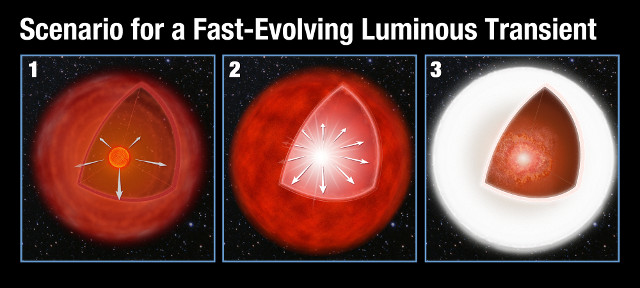
An article published in the journal “Nature Astronomy” describes a research that offers an explanation to a type of extremely bright event called Fast-Evolving Luminous Transient (FELT), that lasts just a few days. A team of researchers took advantage of the ability of NASA’s Kepler space telescope to accurately detect rapid changes in starlight to build a model in which a FELT event is caused by a large shell of gas and dust around a supernova, which makes it shine.
The Kepler space telescope is mostly known as an exoplanet hunter, but its instruments can also be useful for other types of astronomical research. The case of FELT events is one of them after a decade in which researchers tried to understand their nature with difficulty. The main problem is that normal supernovae can be visible even for weeks while FELT events last only a few days and are therefore difficult to study.
Thanks to the Kepler space telescope, it was possible to make new observations of FELT events by recording their light curve. By analyzing the characteristics of the explosion it was possible to understand its mechanism and properties. This allowed to exclude alternative theories that were proposed over the years and conclude that the key to that type of event is in a thick shell of gas and dust.
The researchers focused in particular on an FELT event labeled as KSN 2015K, which lasted just over a week. Reconstructing its dynamics, the model obtained predicts that the supernova’s progenitor star ejects the shell long before the explosion (inset 1 in the image). When the supernova finally occurs (inset 2 in the image), its shock wave hits the shell, transmitting a huge kinetic energy that makes it shine very quickly (inset 3 in the image) but for a limited time.
In these cases there may be more than one shell around the star depending on the number of outer layers ejected from the progenitor star. The final cocoon could be more or less thick with consequences on the duration of the FELT event. Such phenomena are not new, for example in the January 2018 article published in the journal “Monthly Notices of the Royal Astronomical Society” described the study of the ASASSN-15no supernova. Different shell characteristics might lead to different consequences.
These anomalous supernovae of which we see indirect effects can provide new information on the processes that occur during a star’s death throve. For this reason the researchers intend to keep on using the data collected by the Kepler space telescope and in the future the data that will be collected by its successor, the TESS space telescope, for this type of research.


Permalink
If I read this correctly, I have a couple of questions. I am a lay astronomy “fan”.
If the “average” FELT event is due to the shock of an actual supernova striking a pre-released shell of gas from a late evolved star:
1) Shouldn’t “FELT” events be preceded by “normal” supernova behavior?
The ejecta from a SN travels at some value lower than “C”, so the radiation from the supernova should reach us before the secondary radiation from the shockwave hitting an existing, perhaps distant, shell of pre-released material from the late stages of a star’s evolution.
I take it this is not the case, or “FELTS” would be clearly associated with SN events.
2) Given the theorem above, a “FELT” should never even be separately detectable, given the lifetime of most supernova events, correct?
Most SN’s last from days to weeks or longer, and that should cover or “mask” most FELT events, correct?
What am I missing?
Permalink
It’s not accidental that there are still arguments about the processes around each type of supernova. For example, in the cases where the ejecta form a cocoon around the star’s core its light is obscured for a while, until it can pass through those layers. In a FELT event, that means that you see it rather than a normal supernova event.
As I pointed out in the article, different shell characteristics might lead to different consequences. KSN 2015K and ASASSN-15no are just two cases, there might be others with different characteristics such as a thinner shell that allows the normal supernova light to pass through so it’s seen before the FELT event. Also, I wrote that article in march 2018 after a paywalled article was published, more recently this research about KSN 2015K was published on arXiv.